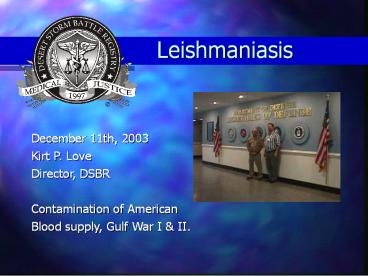Leishmaniasis - PowerPoint PPT Presentation
Title:
Leishmaniasis
Description:
Cutaneous vs L. Tropica. Even though a directive was sent out ... One case at WRAMC showed 43 years after a old cutaneous scar was irritated, the case developed ... – PowerPoint PPT presentation
Number of Views:447
Avg rating:3.0/5.0
Title: Leishmaniasis
1
Leishmaniasis
- December 11th, 2003
- Kirt P. Love
- Director, DSBR
- Contamination of American
- Blood supply, Gulf War I II.
2
Introduction
The 1990 -1991 Gulf War conflict was fought
primarily during the winter season, so the
issue of Sand Fly exposure was minimal. Still,
what has been overlooked by the military medical
monitoring was that Leishmaniasis also
flourishes in wet pools, and then burrows into
the feet of their host.
3
DHSD WRAMC - DHCC
September December 2002
- Our organization met with the
- Pentagons Deployment Health
- Support Directorate on the
- medical fate or troops
- Deploying to Iraq in 2002.
4
DHSD WRAMC - DHCC
September December 2002
- Mike Kilpatrick of DHSD
- stated that the indecisive PCR
- test for Leishmaniasis still
- needed work, and wasnt
- reliable.
5
Cutaneous vs L. Tropica
- Even though a directive was sent out
- by the Army Surgeon General on
- December 23rd, 2002 to monitor
- Leishmaniasis during the present War.
- Diagnosis in the feild was exclusively visual
- observation for lesions. PCR labs or Splenic
- asparate / Bone marrow were not available
- in the desert for non-visual symptoms.
6
UNICEF - Outbreak
Thu 29 May 2003
- Outbreak of Kala-Azar (Visceral Leishmaniasis) in
Iraq - UNICEF has announced an outbreak of Kala-Azar
(Visceral Leishmaniasis) in - Iraq. Though there have been outbreaks of the
disease in Iraq in the past - around this time of year, it is particularly
severe this time. - There are now more than 200 cases of Kala-Azar
reported in Iraq. The - country does see regular outbreaks of the
disease. - UNICEF has warned that this time the outbreak
could be severe. - Kala-Azar is spread mainly by sand flies and
causes malnutrition and - anaemia. When left untreated, the disease is
fatal within 4 to 6 weeks. - Byline Kamini Sawhney (Baghdad)
7
PL 105-85, monitoring
- Pre and Post deployment medical tracking of
- the troops in Afghanistan and Iraq were hastily
- done. So many did not give blood samples
- before leaving, stored by the AFIP.
8
PL 105-85, monitoring
- That blood taken before and after is strictly HIV
- testing, and is not used for other test. The
- Naval Research Medical Center, and others
- have used it for limited recent studies, but it
is - still strictly a military medical operation.
9
Civilian monitoring
- American Physicians are not ready for this Exotic
- Endemic disorder, and will miss cases having
little - previous experience.
- September 12th 2003, William Winkenwerder
- Under Secretary for Health, Veteran Affairs
- Memorandum to Joint Chiefs of Staff,
Leishmaniasis - It is also possible that deployed personnel may
- re-deploy without knowing they are infected
10
Monitoring
New York Times - December 6, 2003Dr. Coleman
found soldiers who got more than 200 bites in a
single night.
- USA TODAY December 4, 2003
- Coleman and Army Lt. Col. Peter Weina, a
leishmaniasis - expert still in Iraq, predicted in April that
there would be 400 - cases, based on the number of bites seen and
tests that show - about one out of 70 sand flies carries the bug.
11
Major vs Tropica
L Major - 1,500,00 cases world wide each year L
Tropica - 500,00 cases world wide each year
The Pentagon recognizes 12 cases of L. Tropica
from the 1991 Gulf War, and 20 cases of L.
Major. The Pentagon is also trying to say there
is almost no L. Tropica present in Iraq. WRAMC
goes as far as to imply the Iraqi L. Tropica is
less virulent.
12
ELISA / PCR
Sept 2003
- Current ELISA accuracy is still between 32
- to 67 with 3 part control under ideal
conditions. - Visceral tissue biopsies are only good after
infection - is severe to terminal.
13
Visceral untreated
- Office of Clinical and Regulatory Affairs,
- National Center For Complementary and
- Alternative Medicine, National Institutes of
- Health
- visceral disease is incurable if untreated.
14
Treatments
Too Expensive!!
- Drug of Choice
- Amphotericin B,
- Streptomyces nodosus
- (photo sensitive 4 to 6
- times a day )
- 48.60 500mg
- Not as effective with
- Visceral
- Pentostam - Diflucan
- 100 MG 50 TAB 300.00
Alternatives Fluconazole 100 MG 50 TAB 300.00
Miltefosine (Impavido) 32.00 100 mg
15
Incubation
With no compulsary reporting of Leishmaniasis
around the world, It is still undetermined what
long term incubations could remain in remission
until turning visceral. One case at WRAMC showed
43 years after a old cutaneous scar was
irritated, the case developed to visceral.
16
Summary
With DOD unable to track this, or unwilling to
pay for expensive advanced labs there is no way
of knowing for sure how many troops coming home
will be infected or with what strain.
Until the lab detection procedures are 100
conclusive, and species specific isnt the risk
of Leishmaniasis to the general public from the
troops too high.
17
Recommendations
With undetermined long term latency for
Leishmaniasis ( Tropica )and the uncertainty of
todays labs, we at DSBR recommend to the FDA a
permanent blood ban on all troops coming home
From Iraq, Afghanistan from 1990 to present. At
a minimum the soldiers blood should not be used
in Vat blood products, or plasma serum based
products.































